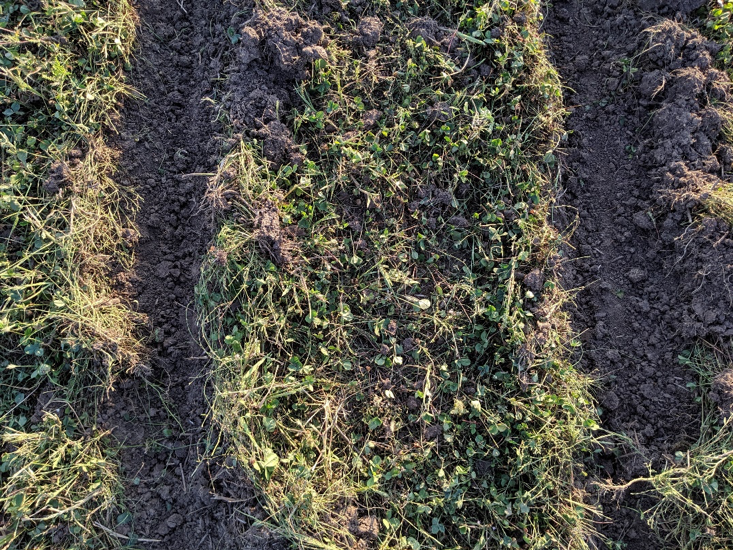
In the final blog from my Romania trip I take a look at the methods used for crop establishment, and how this could overcome some of the main challenges faced by arable farmers back here in the UK.
- Precision Farming
The Farm uses a Controlled Traffic Farming (CTF) system, a management tool which is used to reduce the damage to soils caused by heavy or repeated agricultural machinery passes on the land. This system confines all machinery loads to the least possible area of permanent traffic lanes that are used every year in the crop rotation. The whole range of machinery is set on 9 meters working widths and all tractors and combines are GPS-RTK guidance equipped. Therefore, the tractor and implement travel on exactly the same lines every season. CTF greatly reduces the machinery-based soil compaction to 20%, compared to 50, up to 80% in non-harmonized conventional farming. Reducing soil compaction will improve the soils structure and therefore improve root biomass resulting in improved establishment and growth. It also improves the practicability of fields in wet conditions allowing farmers more viable working days without causing soil damage and also helps to reduce fuel consumption as the soil becomes easier to work, requiring less horse power and machinery passes.
- Weed Control
The farm uses an interrow hoeing to control weeds in the crops, as chemical controls are not possible as the farm is organic. Therefore, the crops are drilled at wide row spacing of 25cm which allows for efficient hoeing between the row without damaging the crop itself. The whole range of weeding machineries is available on the farm: weeder harrows, a rotary hoe, a rotary weeder harrow and two camera-guided hoes which gives the farm many options for different mechanical removal of weeds between the crop rows.
- Crop Establishment
Due to the soil structural improvements from the regenerative system and CTF, the tillage depth has been strongly reduced on the farm in recent years. Ploughing has generally been aborted, replaced by other tillage operations, less destructive for the soil’s structure and biology. Together with the cease of chemical treatments due to the organic status, Nicolas says visible indicators of soil health are clearly improving over time.
Many of the crops are established with as little tillage as possible which helps to sustain the quality of the soil and reduce losses of carbon via oxidation and nitrogen via volatilization to the atmosphere. Nicolas is also experimenting with strip-tillage establishment of crops, which is a conservation system that uses a minimum tillage combining the benefits of conventional tillage with the soil-protecting advantages of no-till by disturbing only the portion of the soil that is to contain the seed row. When I was on the farm, we were drilling the Oilseed Rape in this manner into clover cover crops, disturbing only a small proportion of the soil surface and drilling the seed precisely into the slot.
Nicolas has decided to use stip-tillage for Oilseed crops as, like the UK, it is a notoriously challenging crop to establish in difficult years. The issues are not just pest and disease based, like the UK, but the major issue is retaining moisture in the soil in the hot Romanian summer climate at drilling to get the crop out of the blocks. Strip tillage is clearly a great option for the farm as the soil disturbance is minimum and the ground retains a permanent living cover which helps to create a micro-climate reducing the soil drying effects of wind and sun. In addition to this, the crop is then companion-planted with a legume (in this case red clover) which fixes nitrogen throughout the growing period. This was the first year that Nicolas has used stip-till for oilseed, and we were both eager to find out the results in comparison to the field of conventionally min-tilled oilseed we had also drilled. The early observations looked to be very beneficial in comparison. There was notably more moisture in the strip-till soil and as a result the seed germinated faster which is important as once soil is moved it dries out quickly in warm conditions. There was also seemingly no damage from cabbage stem flea beetle either in comparison to the min-tilled crop where there was significant damage to most plants. This maybe because the strips of no-till act as a more biologically diverse environment and therefore reducing the populations of the problematic pest species. Unfortunately, I was only on the farm for a few weeks so I cannot comment on the crop from then after, however I have asked Nicolas to send my regular updates on the crop progress via Twitter which I look forward to!
All in all, it was a fascinating trip. Stay tuned for more blogs on my travels with the Cator-Gardner Scholarship with Innovation for Agriculture and The Royal Agricultural Society of England.
Joe Collins - Soil and water researcher for IfA
*Note to the reader* - Joe Collins is part of the Soil and Water team here at IfA. In 2018 Joe was awarded the Cator-Gardner Scholarship. This involves a three-month work experience placement working abroad for an innovative agricultural business annually for three years. Joe's latest blogs look back at his recent experiences in Romania, with no-till and CTF enthusiast Nicolas Lefebvre from Exploatatia Agricola Birda.




